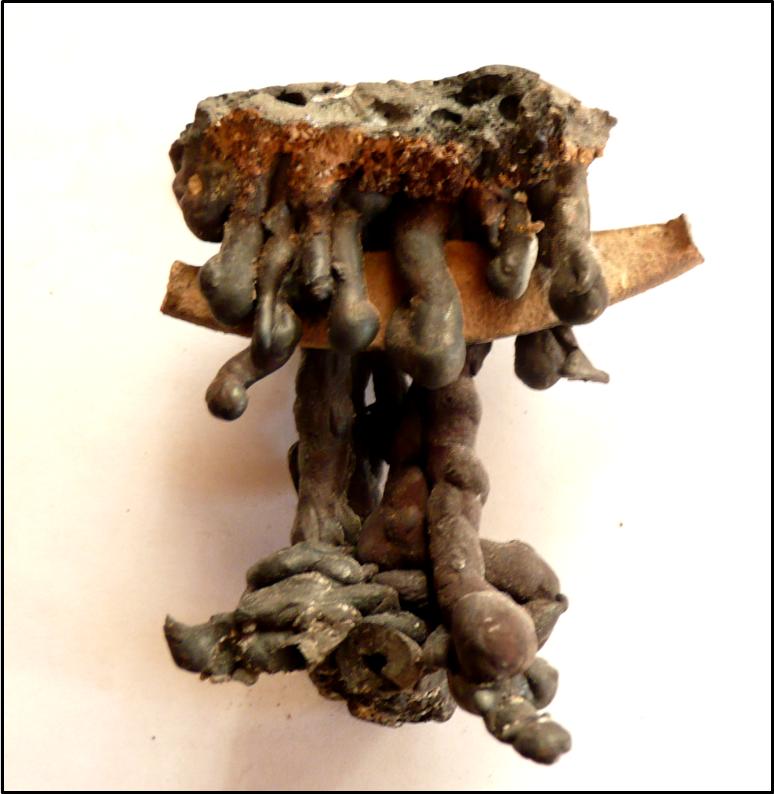 Fig. 1
Fig. 1  Fig. 2
Fig. 2NOTICE (25th June 2010):
FIRST
SMELTING
OF
CHALCOPYRITE
On November 23rd, 2009, smelting copper ore, that is chalcopyrite, the ARCA Group has produced the first small solid metal (Fig. 1), which follows years of experiments in the field of archaeometallurgy, years aimed to retrace and then to propose a procedure and a plausible arrangement similar to those that, in the Copper / First Bronze Age, led to the extraction of copper from metallic sulfides only *.
In the long series of experiments, guided by the simple criterion of trial and error, some knowledge gained from
sixteenth/seventeenth century metallurgy texts and some knowledge of basic
chemistry, we consolidated the belief that the foundry equipment used at that
time could be a simple crucible placed on the fire and one or more nozzles that
breathed the air of the bellows**.
Probably,
at
that time,
a similar system had been designed and used by metallurgists to
derive metal not from the metal sulphides ore but from easier to deal minerals
as copper oxides and carbonates. This website shows an experiment of this
kind, carried out in spring 2009: instead of carbonate, industrial copper
sulphate was used; the process took place with an acceptable efficiency and
a quantity of copper corresponding to around 15% by weight was extracted,
compared to 25% contained therein and theoretically obtainable.
An experiment of copper sulphides smelting is here and now on display in its general outlines: the reached goal has been long pursued by several research groups including Italians and foreigners, but to date, unless contradicted, their experiments have not achieved practical results, but only theoretical ones. Even some websites are reporting information about 'managed' attempts but they have a way of execution which is unlikely even to ancient times.
We now describe our approach:
The mineral we bought on the market, which contains chalcopyrite rich in
copper, has been treated in accordance to this sequence:
1 - fine grinding with mortar
2 - roasting in air
3 - smelting in the crucible with charcoal
As a necessary complement an abundant amount of slag has been achieved which,
incidentally, has leaked from the crucible in the molten state (the slag has
even taken an artistic shape, as shown in Fig.2).
This event was totally unexpected and different to the existing literature on
the subject, in the followed procedure an intermediate stage known as matte
was not produced, a compound of simple sulphides and oxides to be new merger
to reach the black copper. Then the experiment, counting the ore
roasting initial phase, has led to the metal in only two
pyrothecnological steps.
It can be assumed that the lack of matte stadium is due to good roasting,
performed without the admixture of fuel and mineral.
The necessary analysis will show whether the produced copper
consists in black copper or not, a metal which
to
become pure copper, needs the next stage of refining. Analyses will be performed on both the roasted ore, to understand its composition, and the slag in order to verify the efficiency of extraction of copper and iron segregation.
The experiment, copper metal
obtained exclusively
from sulphides,
is
now carried out over and over to strengthen
procedures and to gain certainty in the repeatability of the test ***.
By now, ARCA toasted to the first major achievement.
*
In the experiment
described, the production of air was obtained by an electric fan: in the future
hand bellows will be used.
** It is certainly not excluded that, still later in the Copper Age, the
apparatus consisted of a hollow in the ground lined with clay
*** The new test took place February 28th, 2010: This second
experiment produced copper with characteristics similar to the previous one,
that is grayish-pink color; the metal also has a slight magnetism;
it is likely the aspects find their origin in the presence of a little
haematite in the mineral.
the ARCA Group
 Fig. 1
Fig. 1  Fig. 2
Fig. 2